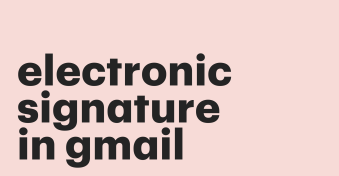An electronic signature is a digital representation of a person’s handwritten signature used to authenticate documents and agreements in a secure and legally binding manner.
How electronic signatures work?
Electronic signatures use cryptographic techniques and secure authentication methods to validate the authenticity and integrity of digital documents.
When a user signs a document electronically, a unique digital signature is created using algorithms that rely on public and private key encryption.
The private key is securely held by the signer and used to generate the signature, while the corresponding public key is widely available for verification.
The digital signature ensures that the document hasn’t been tampered with since it was signed.
Secure authentication methods, such as passwords or biometrics, verify the identity of the signer.
By combining these measures, electronic signatures provide a reliable and legally recognized way to sign documents electronically, offering efficiency, convenience, and trust in digital transactions.
What are the different types of electronic signatures?
Here are the types of electronic signatures and its differences:
| Standard Electronic Signatures | Digital Signatures & Advanced Electronic Signatures | Qualified Electronic Signatures | Wet Signatures | |
|---|---|---|---|---|
| Definition | Basic electronic signatures | Cryptographic signatures with enhanced security | Advanced electronic signatures | Traditional handwritten signatures |
| Legal Validity | Legally recognized in many countries | Legally recognized in most countries | Legally recognized in many countries | Legally recognized in most countries |
| Authentication Method | Username, password, or simple click-to-sign | Encryption and digital certificates for identity verification | Encryption, digital certificates, and Qualified Certificate Authorities (QCA) | Requires physical presence and manual signing |
| Security | Basic security measures | Utilize cryptographic algorithms for integrity and authenticity | Higher level of security with strict regulations and certification | Vulnerable to forgery and tampering |
| Compliance | Complies with basic legal requirements | Meets higher security standards and compliance regulations | Meets strict legal and technical standards for specific use cases | Complies with basic legal requirements |
| Document Integrity | Limited protection against tampering | Provides strong protection against tampering and alteration | Offers advanced features for ensuring integrity and non-repudiation | Can be easily tampered with |
| Audit Trail | Basic audit trail capabilities | Detailed records of the signing process, aiding in audits and disputes | Comprehensive audit trails with timestamps and metadata | Lacks detailed tracking options |
| Storage and Access | Digital copies can be stored and accessed easily | Stored alongside documents in a digital format for easy retrieval | Digital storage and retrieval with advanced security measures | Physical storage and handling required |
Here you can read a separate explanation with more details on each type:
Standard electronic signatures (SES)
Also known as e-signatures or virtual signatures, these are commonly used for online signing.
They rely on the user’s intent to sign as proof of validity. While easy to use, they lack strong security protocols and can be easily refuted.
Digital signatures & advanced electronic signatures (AES)
These signatures require verification of the signer’s authenticity and often utilize public key infrastructure (PKI).
They offer higher security and are ideal for important documents like business contracts. AES must meet specific criteria outlined by eIDAS for legal standing.
Qualified electronic signatures (QES)
Exclusive to the EU, QES incorporates requirements from digital and advanced electronic signatures. It also mandates the use of devices from an EU-authorized certificate authority.
QES carries the equivalent legal effect of a handwritten signature in the EU.
Wet signatures (non-electronic)
While not technically electronic, wet signatures are created using pen and physical paper. They are required in certain legal scenarios where electronic signatures are not valid.
Scanning a wet signature as an image creates a standard e-signature, but it may not hold the same legal standing as a digital signature.
In summary, electronic signatures vary in their level of security and legal recognition.
Understanding the appropriate type for each situation is crucial to ensure compliance and validity.
What are the benefits of using electronic signature?
Between the drive for remote work and anywhere, anytime solutions, businesses have adopted e-signatures and document digitization for a variety of reasons:
✅ Speed. Signing contracts electronically using electronic signatures for PDF contracts is much faster than requiring a handwritten signature, which often requires that a physical contract be sent by mail
✅ Storage. Digital files reduce paper waste, are simple to store, and can be more easily tracked throughout the entire content management lifecycle
✅ Security. When signed correctly, digital signatures are more secure than handwritten signatures, providing additional legal protection in the event of a breached contract or NDA
✅ Streamlining. Using digital tools, e-signatures can be integrated automatically into templates and document formats for an even faster signing experience
How to create an electronic signature
To learn the precise steps for creating an electronic signature on various platforms, explore the guides provided below:
- How to add digital signatures to PDF documents
- How to create a signature in Excel
- How to sign a document on an iPhone
- How to quickly create a scanned digital signature
- How to create a handwritten signature
How to choose electronic signature software?
When selecting electronic signature software, it is essential to consider the following key features:
- Security: Look for software that offers robust security measures such as encryption, multi-factor authentication, and audit trails to ensure the integrity and confidentiality of your documents.
- Compliance: Check if the software complies with relevant regulations like eIDAS in Europe or the ESIGN Act in the United States, ensuring your signatures are legally binding.
- User-friendliness: Opt for software that is intuitive and easy to navigate, allowing both signers and administrators to use it efficiently without extensive training.
- Integration: Consider software that seamlessly integrates with popular business tools like document management systems, CRM platforms, or cloud storage services, streamlining your workflow.
- Customization: Look for software that allows you to customize the signing process by adding your company logo, branding, or personalized fields to enhance professionalism.
- Mobile accessibility: Ensure the software supports mobile devices, allowing signers to conveniently sign documents on smartphones or tablets while on the go.
- Collaboration: Choose software that enables multiple parties to collaborate on a document simultaneously, facilitating real-time discussions and edits.
Impact Networking, a managed services provider, implemented PandaDoc to improve their HR process and document management.
With over 600 employees across multiple locations, PandaDoc allowed Impact Networking to streamline their document workflows, resulting in improved efficiency, productivity, and cost savings for the HR department and other departments within the organization.
“We now have more time to be involved in important things that aren’t administrative tasks, like enhancing our onboarding experience” – Mary Zellers, Director of Human Resources.
- Scalability: Select software that can accommodate your growing needs, whether it’s handling a large volume of documents or supporting multiple users across your organization.
By considering these electronic signature software features, you can find a solution that meets your specific requirements and enhances efficiency in your digital document workflows.
What is the best eSignature platform?
A wide variety of signing solutions exist, including the ability to simply draw and scan your signature or use online signing tools for quick and easy signing.
Here are the most popular options when signing digital documents:
PandaDoc
PandaDoc is a leading electronic signature software known for its comprehensive features.
It offers customizable signature options, including typing, uploading, and drawing signatures.
The software ensures compliance with legal regulations such as ESIGN and UETA.
With PandaDoc, users can create, manage, and track documents efficiently, enhancing productivity.
It provides a user-friendly interface, pre-built templates, and supports mobile signing.
Microsoft Word
Companies using Word to create documents may find that e-signing solutions within the app are easy to incorporate into their normal workflow.
To create digital signatures in Word, you’ll need to use the signature tools to set up a signing process and send out the document to recipients. Learn more here.
PDFs
If you need to add e-signatures to a PDF, you’re most likely to end up using Adobe Sign or Adobe Reader to accomplish this task. Y
you’ll use the “Fill & Sign” or “Add Signature” tools in these applications to quickly create an electronic signature. Learn more here.
Google Docs
Natively, Google Workspace doesn’t support e-signing.
To digitally sign your Google Doc, you’ll want to add an extension to your Google Workspace.
Select your preferred e-signature solution from the add-ons menu and install it.
After the add-on is installed, you’ll need to log into your signing solution of choice in order to complete the e-signing process. Learn more here.
DocuSign
DocuSign is a prominent competitor to PandaDoc in the electronic signature software market. DocuSign provides a seamless and intuitive experience for users.
The platform boasts strong industry recognition and a wide range of integrations with popular business tools.
However, compared to PandaDoc, DocuSign may not offer as extensive document management capabilities.
Pricing plans for DocuSign tend to be on the higher side, which could be a consideration for budget-conscious users.
Ultimately, the choice between DocuSign and PandaDoc depends on specific requirements and preferences.
What makes signatures legal?
Signatures are considered legally binding when they signify an individual’s voluntary agreement and intent to be bound by the terms of a document or contract.
Whether handwritten or electronic, several factors contribute to the legality of signatures.
These factors include the clear expression of consent, the authenticity and identity verification of the signatory, the absence of duress or coercion, and compliance with applicable laws and regulations.
It is important to note that specific requirements for legal signatures may vary depending on jurisdiction.
How can I learn more about eSignatures?
Explore free webinars and articles to master your knowledge of eSignatures, quotes, proposals, and contracts.
From understanding their legal validity to harnessing their power in streamlining document workflows, our comprehensive curriculum covers it all.
Join live classes where industry experts will guide you through best practices and answer your burning questions.
How to create an electronic signature
Your ultimate guide on how to create an electronic signature: from e-signing your PDF, Word documents, Google Docs, Exel to using various free and paid software.
With PandaDoc Blog you can easily navigate through categories from industry experts.
You’ll find immense value in the blog’s content from legal-related questions around eSignatures or contracts to regular posts covering all aspects of document automation.
Deep dive into Frequently asked questions on PandaDoc ask pages.
Anticipate and answer the most commonly asked questions, saving time and providing clarity regards electronic signature, its validity, use cases and so much more.
Additional articles on eSignature
Here, you’ll find a list of sources for legal documentation for electronic signatures in both the United States and the European Union.
You can also check out our e-signature legalities page for additional information on electronic signatures in other countries.
United States
- Uniform Electronic Transactions Act
- Electronic Signatures in Global and National Commerce Act
- FDA Electronic Signature Regulations
European Union
- eIDAS Regulation
- United Kingdom Department for Business, Energy & Industrial Strategy on Electronic Signatures and Trust Services
- General Data Protection Regulation (GDPR)
Wrapping up
Do you have additional questions about electronic signatures or the electronic signing process?
Have an idea for how we can make this ultimate guide even better?
Contact us and let us know!
Disclaimer
Parties other than PandaDoc may provide products, services, recommendations, or views on PandaDoc’s site (“Third Party Materials”). PandaDoc is not responsible for examining or evaluating such Third Party Materials, and does not provide any warranties relating to the Third Party Materials. Links to such Third Party Materials are for your convenience and does not constitute an endorsement of such Third Party Materials.
Originally published June 24, 2021, updated September 4, 2023


